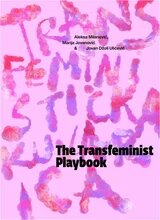The Transfeminist Playbook
Anti-democratic forces often instrumentalise gender identity in order to gain political power, thus further marginalising and oppressing queer communities. The Transfeminist Playbook (Transfeministička kuvarica) offers tools for counteracting, resisting and challenging anti-gender rhetoric. The publication made by Trans Mreza Balkan serves as a guide for communicating, and building solidarity within feminist and democratic movements while addressing the harmful impact of anti-gender narratives.
Transfeminism is not separate from feminist struggles; it is an integral part of the broader fight for reproductive justice, bodily autonomy, integrity and human rights.
The Playbook is a practical toolkit for trans, gender diverse people, and allies providing real-life strategies, but also a call for action and solidarity.
Authors:
Jovan Dzoli Ulicevic, Montenegro
Activist and founder of several queer feminist organizations (Spektra, Trans Mreža Balkan, LGBTIQ Association of Queer Montenegro). Biologist and ecologist, currently finishing International Relations at Humanity Studies. The focus of his work is anti-fascism, queer activism, feminism and decolonialism. Dzoli also serves in the Activist Circle of Guerilla Foundation.
Aleksa Milanović (PhD), Serbia
Associate professor at the Faculty of Media and Communications in Belgrade and the author of two books: Representation of Transgender Identities in Visual Arts (2015) and Media Construction of Other Body (2019), end co-editor of the book Transgender in the Post-Yugoslav Space: Lives, Activisms, Culture (2022). Involved in LGBTIQ+ activism since 2008 and is a founding member of Trans Network Balkan in 2014, and Kolektiv Talas TIRV (Collective Wave TIGV) in 2020.
Marija Jovanović, Montenegro
Activist from Podgorica, born in 1997. Third year in the psychology department of the Faculty of Applied Sciences. An activist for the human rights of LGBTIQ people, a feminist and one of the founders of the Association Spektra, where Marija communicates feminist values and mainstreaming understanding of the mechanisms of oppression, and the interaction of the personal with the structural and political.
Product details
Table of contents
Aleksa Milanović, Marija Jovanović & Jovan Džoli Ulićević
The Transfeminist Playbook
Introduction .................................................................................. 7
What kind of narratives are we fighting .............................. 11
General guidelines for transfeminist argumentation .......... 20
Who are we communicating with? .......................................... 20
How do we know who belongs to the movable middle? .... 21
What Is the Basis of Anti-Gender Communication
and of Transfeminist Communication? ................................. 26
How Do We Communicate Our Messages Effectively? ...... 29
Anti-Gender Arguments: How Can We Respond? ............. 34
Identities and Terminology ....................................................... 50
Literature ...................................................................................... 56
ANTI-GENDER NARRATIVES
Case studies: Croatia, Serbia, and Montenegro
Introduction .................................................................................. 59
Amir Hodžić & Erin Vlahović
Anti-Gender Policies in Croatia 2022–2023 ........................ 60
Intensification of transphobia in the public and political space
in the Republic of Croatia 2022–23:
the case of the Zagreb Straight Pride initiative –
from a tasteless joke to a political party ............................. 61
Events and Actors ....................................................................... 63
Political Organizing .................................................................... 64
Discourses against so-called “gender ideology” ................ 66
Reactions ..................................................................................... 69
Actions and connections ........................................................... 73
Postscript ..................................................................................... 76
The case of the "mandatory workbook for parents":
a decade of creating fear, panic and hatred ....................... 78
Topics and Arguments .............................................................. 80
Actors and Actions ...................................................................... 86
Reactions ..................................................................................... 88
A decade of anti-gender campaigns: The example of Vigilare ....... 89
Literature ................................................................................................... 91
Dragana Stojanović & Aleksa Milanović
Identifying mechanisms for understanding the survival and
development of anti-gender policies in the Republic of Serbia:
the case of introducing gender-sensitive language (2018–2023)
and the case of textbook censorship (2021–2022)........................... 92
Introductory orientations: anti-gender politics at the intersection
of continuity and new articulations ..................................................... 93
Mapping the framework of activity: anti-gender policies
and their social carriers ...................................................................... 95
CASE STUDY 1:
Introduction of gender-sensitive language into
the legal framework of the Republic of Serbia ........................................... 98
CASE STUDY 2: School Textbook Censorship ............................................. 110
A school textbook lesson becomes news in the mainstream media ...... 111
Reviving the textbook issue on the eve of the EuroPride ............................. 116
Withdrawal of textbooks: censorship of professional
and scientific thought .......................................................................................... 120
Literature ............................................................................................................... 123
Nađa Bobičić & Jovan Džoli Ulićević
Anti-gender narratives in Montenegro – the use of democratic
methods against gender and democracy ................................................... 124
Methodology ........................................................................................................ 129
CASE 1:
Moleban of the Serbian Orthodox Church for the
"Sanctity of Marriage and Family" ................................................................ 130
Anti-Gender Rhetoric of the Serbian Orthodox Church
in Montenegro ..................................................................................................... 130
Who Are the Key Anti-Gender Actors? ............................................................ 131
Serbian Orthodox Church in Montenegro:
From Amfilohije through Jovan Plamenac and Velibor Džomić
to Gojko Perović and Joanikije Mićović .......................................................... 131
STATE ACTORS: From the Democratic Front and the
Socialist People's Party to the Christian Democrats .................................. 138
WHO ARE THE KEY PROGRESSIVES?
Montenegro pride ...............................................................................................140
Representatives of Political Parties and Embassies ................................. 142
Media .................................................................................................................... 144
CASE 2:
Abortion Debate on Montenegro's Public Broadcaster .......................... 145
Who Are the Key Players in the Debate? ...................................................... 149
State actors ........................................................................................................ 149
Progressive Actors — Feminists and Activists ........................................... 151
Serbian Orthodox Church in Montenegro .................................................... 155
Conclusion ....................................................................................................... 158
What Are the Key Messages? ....................................................................... 161
Literature ........................................................................................................... 162
Author biographies .......................................................................................... 163
